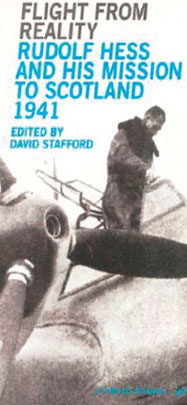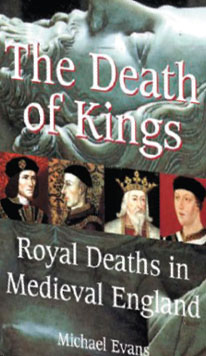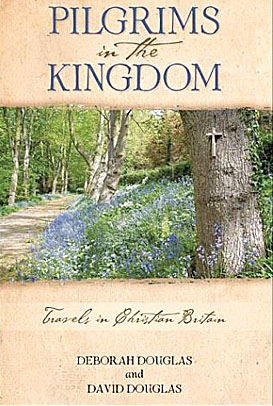
[caption id="TheLatestBooksAboutBritain_img1" align="aligncenter" width="187"]

[caption id="TheLatestBooksAboutBritain_img2" align="aligncenter" width="297"]

[caption id="TheLatestBooksAboutBritain_img3" align="aligncenter" width="206"]

[caption id="TheLatestBooksAboutBritain_img4" align="aligncenter" width="273"]

Flight from Reality: Rudolf Hess and His Mission to Scotland 1941, edited by David Stafford. Pimlico Books, London. 182 pages, $19.95 softcover.
RUDOLF HESS MADE HIS STRANGE AND unexpected flight to Scotland in May 1941, and today he seems to be less a historical figure and more a mirror in which people see their own obsessions reflected back at them. Depending on where they stand, Hess was either crazy, a eat’s paw in the subtle and devious plots of the British secret services, evidence of a near-traitorous British “peace party,” the personal emissary of Adolf Hitler himself, or a mysterious someone who was not Rudolf Hess at all.
Flight from Reality, a collection of eight papers originally presented in 2000 at a Rudolf Hess symposium in Edinburgh, avoids funhouse mirrors with sober and non-controversial views of the case. Conspiracy theorists need not apply. “Despite the many speculations and insinuations surrounding the spectacular flight of Hitler’s Deputy to Scotland on 10 May 1941 it can be stated with some certainty that ‘The Facts about Rudolf Hess’ are, by now, well known,” writes Lothar Kettenacker in his chapter.
Kettenacker, Deputy Director of the German Historical Institute in London, examines why Winston Churchill’s Government failed to exploit what should have been a marvellous propaganda coup. He concludes that the British played their cards close to the vest so they could keep Soviet dictator Josef Stalin guessing about Hess’s intentions and thus prevent a possible Soviet-Nazi rapprochement. Instead, the British merely helped fuel Stalin’s paranoia.
John Erikson, a Soviet expert and Professor Emeritus at the University of Edinburgh, uses declassified files to examine the Hess case from the Soviet side. One interesting revelation is that superspy Kim Philby informed Moscow that Britain intended to keep Hess as “the trump card in waiting” in case it needed to negotiate a separate peace with Hitler. Although untrue, this allegation fuelled Stalin’s suspicions about his British allies, leading to increased tensions after the war.
Other chapters look at Hess’s mission from an aviation perspective (by novelist and historian Len Deighton) and at the American reaction, consider Hess’s role in Nazi Germany and the part played in his mission (by Karl and Albrecht Haushofer), and provide an overview of public records on the case. Hugh Trevor-Roper provides a final summation of the Hess mission. As historical evidence it all appears very solid—if somewhat dry—but it probably won’t satisfy conspiracy theorists, who can always argue that the best conspiracies are those that remain unproven.
—TOM HUNTINGTON
The Ship: Retracing Captain Cook’s Endeavour Voyage, by Simon Baker. Hydra Publishing, 50 Mallard Rise, Irving, New York 10533. 224 pages, $27.50 hardcover.
IN AN ERA OF instant global communication, it seems unimaginable that as recently as the mid-1700s, a huge swath of the world, the South Pacific, was unexplored and unknown to Europeans. The three-year voyage of Captain James Cook in the bark Endeavour, setting sail from Plymouth in August 1768, largely completed the map of the world.
The voyage’s public purpose was to observe the Transit of Venus from the southern hemisphere. This event, an eclipse observed from various points across the globe, would allow scientists for the first time to make accurate measurements of the size of the sun, the earth’s distance from it, and ultimately the size of our solar system.
Beyond this public purpose, however, Cook’s brief was to chart the unknown waters and lands of the South Pacific. And so he did, defining New Zealand, Australia, New Guinea, and a number of island groups. In the process, with a team of astronomers, botanists, and artists, Cook brought back to England the discovery of thousands of flora and fauna species, and a rudimentary introduction to a score of indigenous peoples.
In 2001, a replica of the ship Endeavour set out to duplicate a portion of Cook’s voyage under conditions closely approximating those of the 18th-century expedition. Commissioned by the BBC, a volunteer crew set out in the tiny wooden vessel for a six-week, 3,500-mile voyage that followed the route of Cook’s journey. The adventure was documented on film and became a popular series aired on The History Channel.
Simon Baker, who was aboard the Endeavour, produced the series. The Ship is the companion book to the series but stands admirably alone, recounting the challenges of the vessel and crew following in Captain Cook’s wake.
In addition to documenting the complexities of navigating, living aboard, and sailing an 18th-century bark, Baker superbly interlines the story of Cook’s original voyage and the important role it played in several fields of scientific knowledge, imperialism, and the advancement of navigation. He produces a very readable account of both voyages, drawing upon the journals of the 1770 and 2001 participants. Lavishly illustrated with colour photos, maps, and the artwork returned on the original Endeavour, Baker’s book stands as a superior example of travel writing that goes beyond personal experience to a rich historical context.
Baker succeeds admirably in examining Cook and his team in their own times and in making their voyage of discovery much more meaningful in the context of today’s world. The result is a book that is both history and travel writing at its best.
—DANA HUNTLEY
The Death of Kings: Royal Deaths in Medieval England, by Michael Evans. Hambledon & London, 17 5 Fifth Avenue, New York, New York 10010. 320 pages, $29.95 hardcover.
“A TIME TO BE BORN, and a time to die”; it happens to kings and commoners alike. From the time of the Norman Conquest until the Tudor renaissance, the death of kings was almost never as simple as: “The king is dead, long live the king.”
When medieval kings died, their death throes had an impact on society at many levels. Their manner of death, behaviour at death, the political circumstances at the time, and the state of the succession were all matters of consequence surrounding a royal demise. Chroniclers moralized upon the spiritual lessons of the monarch’s life and passing. Courtiers and nobles jockeyed for advantage under a new reign. The posthumous treatment the corpse received depended upon who laid hands on it first.
The Death of Kings examines all of these repercussions, and more, surrounding the deaths of kings from William the Conqueror to Richard IlL Michael Evans has written a detailed study on the circumstances, impact, and aftermath of royal deaths through England’s middle ages.
Not surprisingly, Evans focuses principally on what he acknowledges to be the interesting deaths, those of the eight kings in this 400-year period whose ends were violent. These are, after all, the royal passings fraught most with political and moral consequences. It was generally held through the middle ages, particularly among the principally clerical historians of the time, that death was the judgment of God. The deaths of God’s anointed kings always provoked speculation on where and how that judgment was directed.
As the king was a semi-sacral figure, regicide was looked upon with particular horror. Four medieval kings were victims of royal murder: Edward II, Richard II, Henry VI, and Edward V. The circumstances and ambiguities surrounding their deaths is as intriguing to the modern reader as it was for the chroniclers and people of their own times. In these complex cases as elsewhere, Michael Evans provides a comprehensive context without pretending to conclusions of his own.
There were, of course, monarchs who died a “good death,” with time to make their peace with God, settle their worldly affairs, and compose themselves for death with serenity of mind. Despite the popular desirability for such ends in the middle ages, however, they were relatively rare for kings. And peaceful deaths, after all, were not interesting deaths.
Evans is a historian, not a “popular” writer. His text is heavily documented and his vocabulary scholarly. At the same time, his writing style remains clear and readable. Far from being a macabre and ponderous treatise, Evans’ book illumines not only the significant historical importance of his subject, but contributes to a broader understanding of medieval England as well.
—DANA HUNTLEY
Pilgrims in the Kingdom: Travels in Christian Britain, by Deborah Douglas and David Douglas. Published by Upper Room Books, 1908 Grand Avenue, Nashville, 1N 37212.255 pages, $17 softcover.
DESPITE ITS OVERUSE as a metaphor for travelling in general, a proper pilgrim is one motivated by a devout or sacred purpose. Deborah and David Douglas are proper pilgrims indeed. Their travels to a number of important spiritual and historical sites in Britain is driven by a firm belief in the notion of “sacred space” as much as it is by their own Christian faith.
In truth, this is a book that may be more annoying than edifying for a nonbeliever, for it is as much a record of personal devotion and meditation as it is an account of travel. At the same time, for those who share a fundamentally Christian world view, the Dou-glases illuminate and inform the stories of 16 significant figures in British church history and the principal places associated with them.
Rather than attempting to tag-team their writing, this husband and wife team write individually by chapter, personalizing their experiences across the island from Iona to Canterbury Cathedral. To remarkable effect, the Douglases order their pilgrimage chronologically rather than geographically. They begin with Saint Ninian, who first brought Christianity to southern Scotland in 397, and continue through T.S. Eliot and the Little Gidding of the poet’s affirmative Four Quartets.
Along their journey through Christian history, the reader encounters such diverse people as Becket, Julian of Norwich, the metaphysical poet George Herbert, Quaker founder George Fox, Wesley, Gerard Manley Hopkins, and C.S. Lewis. In each case, the authors attempt to connect the “sense of place” to these figures’own devotional and intellectual pilgrimages.
For travellers, David and Deborah spend too much time having tea in lonely bed & breakfasts and not enough time in the pub. Their solitary meditations and quasi-mysticism become cloying and a distraction from the figures and places that are the objects of their visits. The practice of writing solely in the present tense, though intended to create diary-like intimacy, tends to have the same effect.
These caveats aside, however, Pilgrims in the Kingdom succeeds admirably in its purpose. It informs, enlightens, and inspires travel to such places as St. Margaret’s Chapel, Bemerton and Aldersgate Street. Certainly there is some idiosyncrasy in their choices of who to include in what is presented as a pantheon of spiritual giants in British history, but that is the privilege of authorship. Since the couple based their stay in St. Andrews, the absence of John Knox seems telling. John Bunyan, St. David, Thomas More, Milton, Newman, Lord Shaftesbury, and William Carey come to mind as among the missing as well.
Perhaps this smattering of historic figures who were not profiled here may inspire the authors to return to Britain for another pilgrimage, and a second volume. It would be most welcome.
—DANA HUNTLEY





Comments